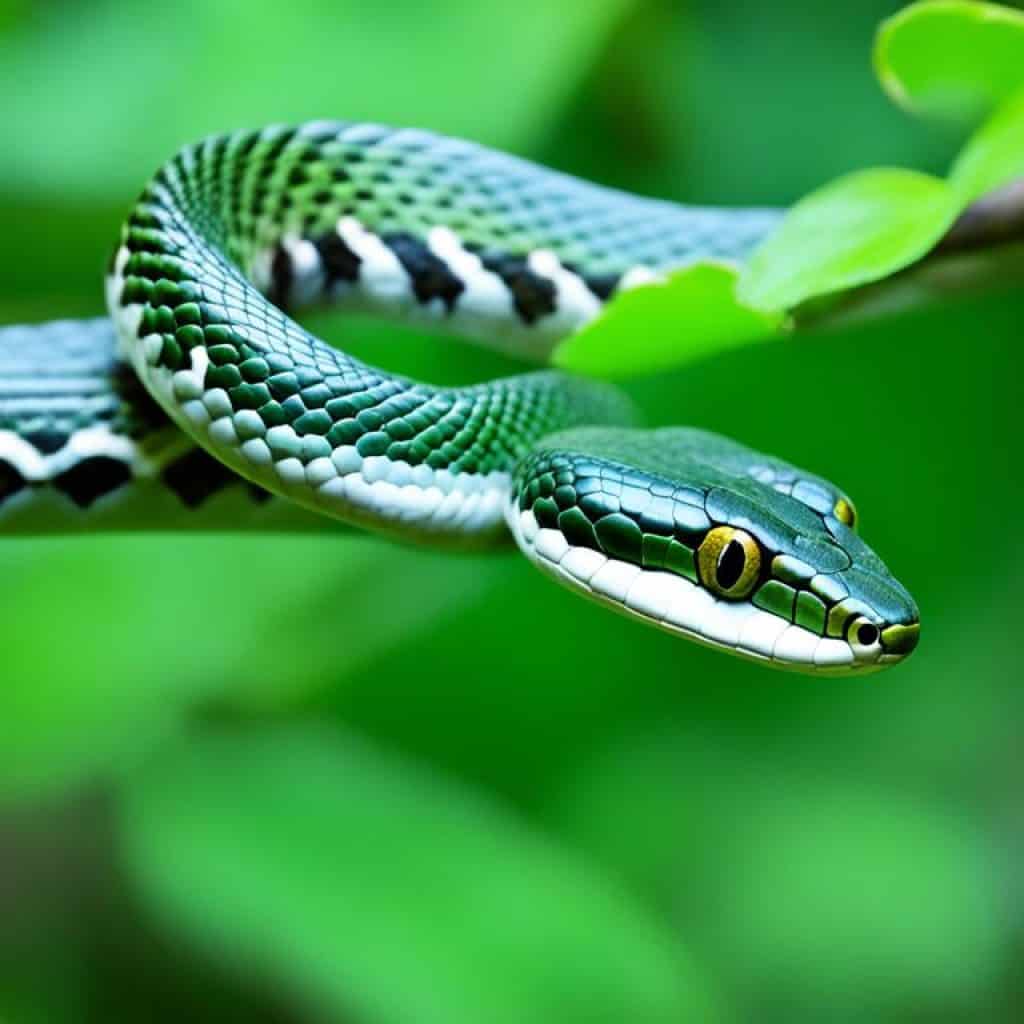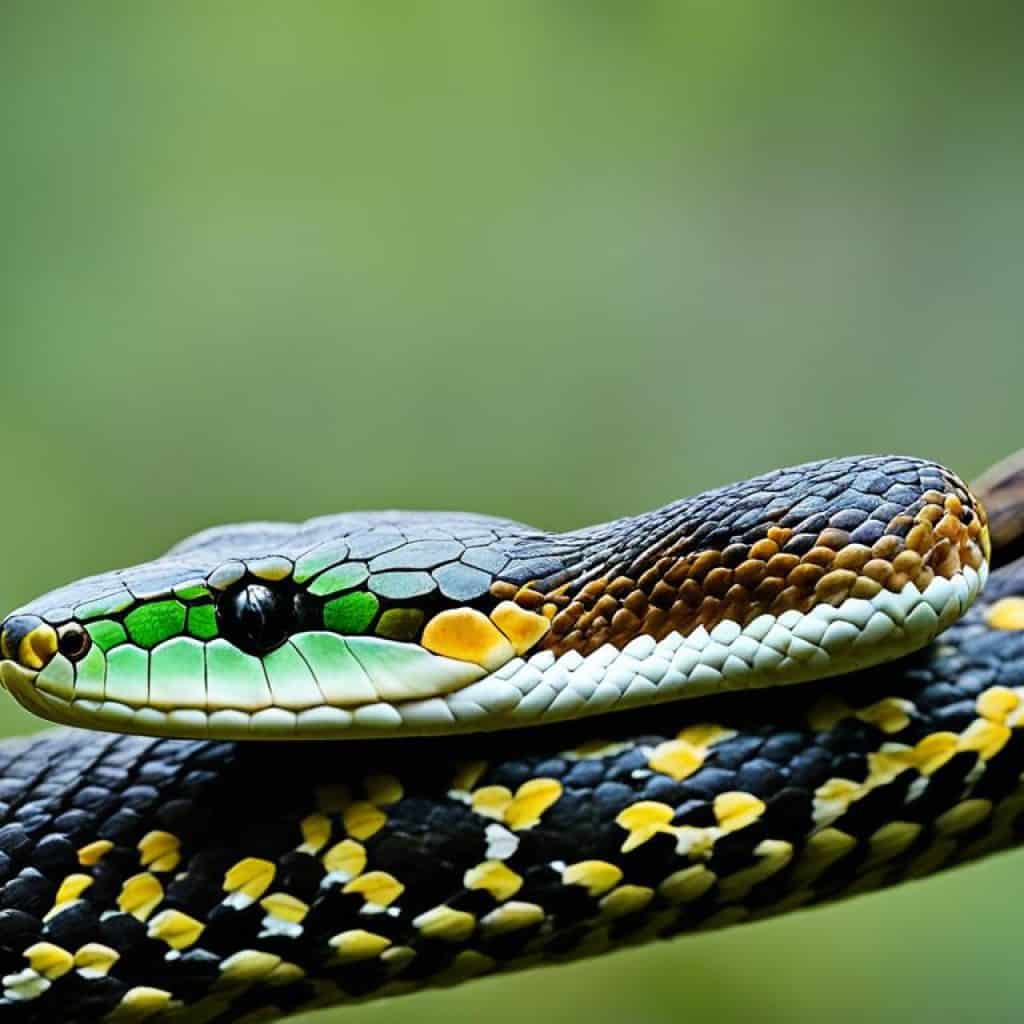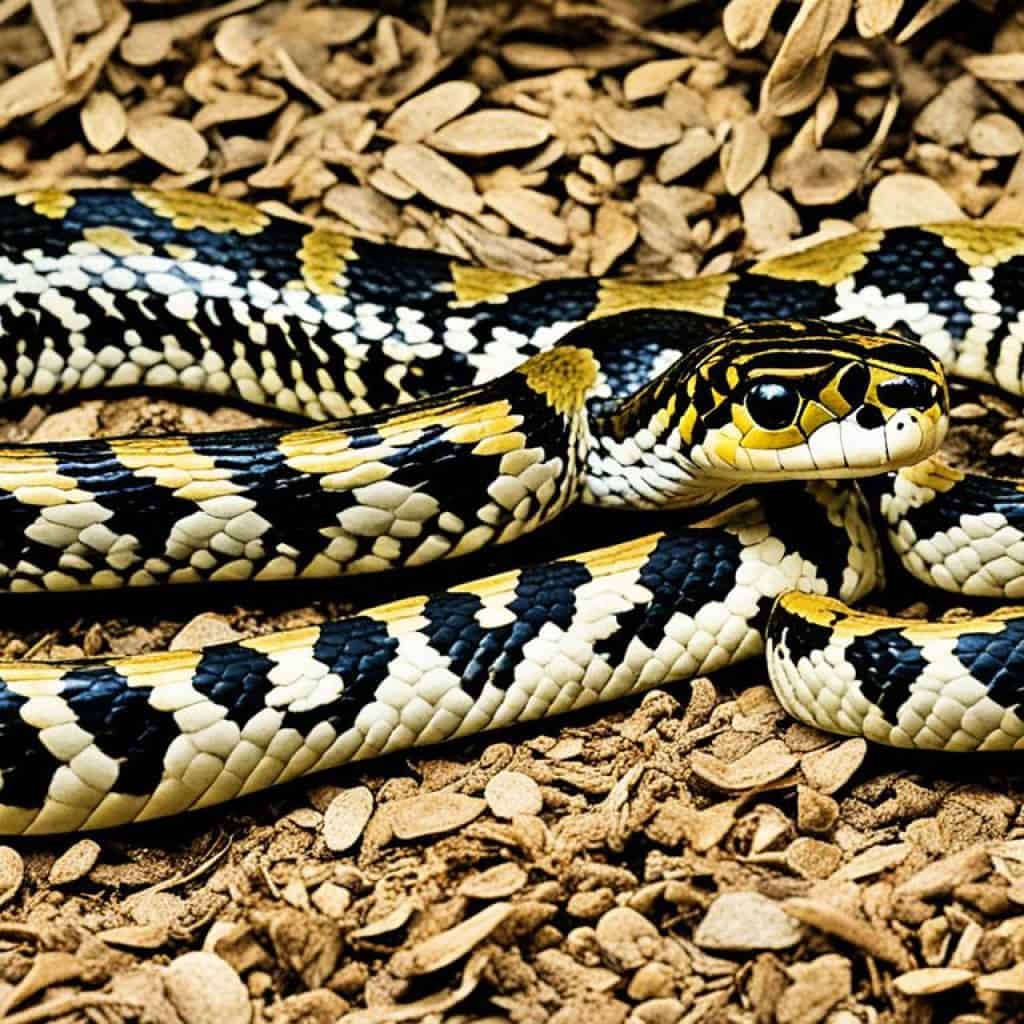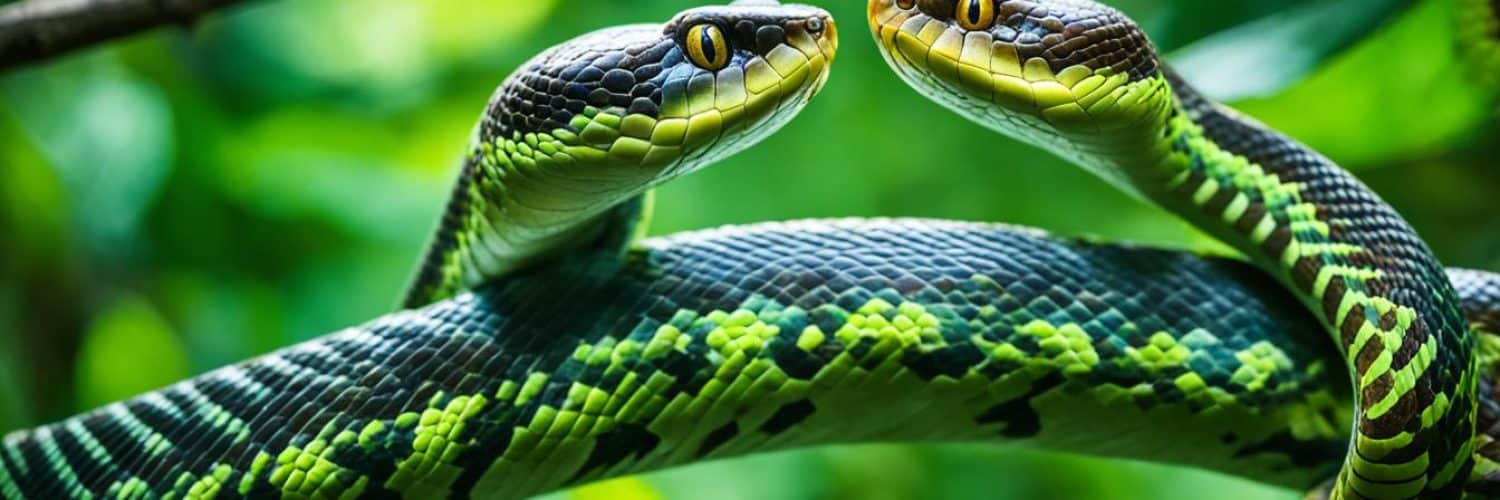Did you know that not all snakes in the Philippines are venomous? Contrary to common beliefs, there are actually many safe and harmless snakes found in the country. But how can you identify them? And what are their behaviors and ranges? In this article, we will explore the fascinating world of non-venomous snakes in the Philippines, providing you with valuable information to better understand these unique creatures.
Key Takeaways:
- Not all snakes in the Philippines are venomous.
- There are many safe and non-venomous snake species in the country.
- Identification, behavior, and range are important factors in understanding non-venomous snakes.
- Appreciating the diversity of non-venomous snakes contributes to the country’s biodiversity.
- Understanding the differences between venomous and non-venomous snakes is crucial for safety and conservation efforts.
Common Mock Viper
The Common Mock Viper, known as Psammodynastes pulverulentus, is a non-venomous snake species native to the Philippines. It can be easily identified by its distinctive brown coloring with darker brown and white flecks. The head of the Common Mock Viper is paddle-shaped and wider at the back, adding to its unique appearance.
Despite its name, the Common Mock Viper is harmless to humans. In fact, it is known for its incredible ability to mimic venomous snakes as a defense mechanism. This clever adaptation helps it avoid potential predators and ensures its survival in the wild.
The Common Mock Viper is primarily found in tropical wet forests, where it thrives in the lush vegetation. It is also an adept climber, which allows it to navigate through the trees with ease. Its range includes various regions in the Philippines, making it a fascinating and important part of the country’s biodiversity.
If you ever come across a snake that resembles the Common Mock Viper, remember that it is a non-venomous species. Appreciate its remarkable mimicry skills and let it go about its business in its natural habitat.
“The Common Mock Viper showcases nature’s amazing ability to adapt and survive. Its harmless nature and mimicry skills make it a truly fascinating snake species.” – Snake Enthusiast
Key Characteristics of the Common Mock Viper:
- Brown coloring with darker brown and white flecks
- Paddle-shaped head, wider at the back
- Non-venomous and harmless to humans
- Excellent mimicry skills, resembling venomous snakes for defense
- Primarily lives in tropical wet forests
- Skilled climber
- Range includes various regions in the Philippines
Comparison of the Common Mock Viper with Venomous Snakes
| Characteristics | Common Mock Viper | Venomous Snakes |
|---|---|---|
| Coloring | Brown with darker brown and white flecks | Varies depending on species |
| Head Shape | Paddle-shaped, wider at the back | May differ among species |
| Venom | Non-venomous | Possesses venom for prey capture |
| Behavior | Non-aggressive, harmless to humans | Varies among species |
| Range | Various regions in the Philippines | Varies by species and habitat |
Stay tuned for the next section, where we will explore another fascinating snake species found in the Philippines.
King Cobra
The King Cobra, scientifically known as Ophiophagus hannah, is the longest venomous snake in the Philippines. It can reach lengths of 3-3.6 meters, with some specimens growing up to 5.4 meters. The King Cobra has an olive green color with black and white bands on its body. It has a prominent hood that opens in a defensive stance. While this species is not considered particularly aggressive towards humans, it can be defensive when its eggs are threatened. The venom of the King Cobra is highly potent and can cause serious harm to humans. It is best to maintain a safe distance if you encounter a King Cobra in the wild.
Key features of the King Cobra:
- Olive green color with black and white bands
- Prominent hood that opens in a defensive stance
- Can reach lengths of 3-3.6 meters, with some specimens growing up to 5.4 meters
- Considered the longest venomous snake in the Philippines
Range of the King Cobra:
The King Cobra is found in various regions of the Philippines, inhabiting a range of habitats including forests, grasslands, and agricultural areas.
| Habitat | Range |
|---|---|
| Tropical forests | Throughout the Philippines |
| Grasslands | Throughout the Philippines |
| Agricultural areas | Throughout the Philippines |
Oriental Whipsnake
The Oriental Whipsnake, scientifically known as Ahaetulla prasina, is one of the most colorful non-venomous snakes found in the Philippines. With its slender body and long, pointed snout, it is easily recognizable. The Oriental Whipsnake possesses a stunning range of colors, ranging from light brown to dull yellow-green and even fluorescent green. Some individuals also display a captivating checkered pattern of light and dark green scales.
This particular species of snake is arboreal, meaning it is mainly found in forest edge habitats. It is active during the day, making it a diurnal creature. The Oriental Whipsnake primarily feeds on small nesting birds, lizards, and tree frogs. While it is mildly venomous, its venom poses no significant harm to humans.
If you come across a snake that matches this description, you may have encountered an Oriental Whipsnake. Remember to keep your distance and admire its vibrant beauty from afar.

Reticulated Python
The Reticulated Python, scientifically known as Malayopython reticulatus, is the largest snake species in the Philippines. It can grow to lengths of 1.5-6.5 meters and weighs up to 75 kilograms. The coloring of the Reticulated Python is a mix of brown, beige, black, gray, white, and yellow in a complex geometric pattern. This species can be found in woodlands, rainforests, and grasslands, as well as near rivers and lakes. The Reticulated Python is an ambush predator and primarily feeds on mammals and birds. While it is non-venomous, its size and strength allow it to prey on humans, making it potentially dangerous.
| Species | Scientific Name | Length | Weight | Coloring | Habitat | Primary Diet |
|---|---|---|---|---|---|---|
| Reticulated Python | Malayopython reticulatus | 1.5-6.5 meters | Up to 75 kilograms | Mix of brown, beige, black, gray, white, and yellow | Woodlands, rainforests, grasslands, near rivers and lakes | Mammals and birds |
As you can see from the table above, the Reticulated Python is a remarkable snake species found in the Philippines. Its immense size, intricate coloring, and diverse habitat make it a fascinating creature to observe. However, it is important to exercise caution and maintain a safe distance when encountering a Reticulated Python in the wild due to its predatory nature and ability to prey on humans.
Brahminy Blindsnake
The Brahminy Blindsnake, also known as the Flowerpot Snake, is the smallest snake species found in the Philippines. Measuring only 5.1 to 10.2 centimeters in length, it is truly a tiny creature. Despite its size, the Brahminy Blindsnake possesses unique characteristics that make it fascinating to study.
The coloring of the Brahminy Blindsnake varies from charcoal gray to light yellow-beige, silver-gray, purplish, and even white. Its worm-like body shape and small size often lead to misconceptions, with many mistaking it for an earthworm. However, this little snake is far from being a slimy creature hiding in the dirt.
Indotyphlops braminus, commonly known as the Brahminy Blindsnake, has adapted to a life mainly underground in ant and termite nests. It is almost completely blind and relies heavily on its sense of touch to navigate its environment.
“The Brahminy Blindsnake’s appearance and behavior may be deceiving at first glance, but it is a harmless and intriguing species.”
While the Brahminy Blindsnake may not draw much attention due to its small size and subterranean lifestyle, it plays a crucial role in maintaining ecosystem balance. Its diet primarily consists of ants and termites, helping to control their populations and contributing to the overall health of the ecosystem.
Next time you find yourself in the Philippines, keep an eye out for the Brahminy Blindsnake. Despite its diminutive size and humble appearance, it serves as a reminder of the incredible diversity and fascinating adaptations found in the world of snakes.
Eastern Blackneck Garter Snake
The Eastern Blackneck Garter Snake is a non-venomous snake species found in the Philippines. It is significantly smaller than its cousin, the Western Blackneck Garter Snake, reaching lengths of only 20 inches. This species prefers to live in dry land near water and feeds on small fish, amphibians, lesser snakes, and invertebrates.
The Eastern Blackneck Garter Snake has a dark-colored body with three light stripes of yellow, orange, and black evenly spread throughout it.
Long-Nosed Snake
The Long-Nosed Snake is a fascinating and beautiful non-poisonous snake species that can make for an exceptional exotic pet. With its distinctive long, upturned snout, this snake stands out from others in its appearance and characteristics. It grows to a length of up to 30 inches, making it a manageable size for pet owners.
What sets the Long-Nosed Snake apart is its tricolor body pattern. With black and red saddling or yellow and cream bandings, this snake displays an eye-catching combination of colors that adds to its allure.
This non-poisonous snake primarily feeds on amphibians and lizards, and it does not eat rodents. This makes it a unique choice for those looking to own an exotic pet that has specific dietary requirements.
If you are considering adding an exotic pet to your family, the Long-Nosed Snake could be a delightful and visually captivating addition. Its non-poisonous nature and tricolor body make it a safe and fascinating choice for reptile enthusiasts.
| Key Features | Description |
|---|---|
| Length | Grows up to 30 inches |
| Snout | Characterized by a long, upturned snout |
| Coloring | Tricolor pattern with black and red saddling or yellow and cream bandings |
| Diet | Primarily feeds on amphibians and lizards; does not eat rodents |
Consider the Long-Nosed Snake as a unique and captivating pet that will draw attention with its tricolor body and fascinating features.

Scarlet King Snake
The Scarlet King Snake is a fascinating non-poisonous snake species commonly found in the United States. It is the smallest among all king snakes, measuring up to 68.4 centimeters in length. Despite its small size, this snake possesses distinct characteristics that make it a captivating creature.
One notable feature of the Scarlet King Snake is its unique diet. As an adaptable predator, it feeds on a variety of small creatures, including birds, rodents, amphibians, and invertebrates. This diverse menu allows the Scarlet King Snake to thrive in different habitats, making it an efficient and successful hunter.
“The Scarlet King Snake’s diet is essential for its survival and growth. By consuming a range of small prey, it ensures a balanced and nutritious intake of food.”
From birth, Scarlet King Snakes display striking black, red, and white bandings. However, as they mature, their colors transform, developing shades of yellow amidst their vibrant patterns. This remarkable transformation adds to the allure of these snakes and makes them a captivating sight in their natural habitat.
The Scarlet King Snake’s small size makes it a manageable and less intimidating snake to encounter. Its non-poisonous nature further reassures individuals of its harmlessness. However, it is important to remember that, like any wild animal, it is best to observe from a distance and respect its natural habitat.
Scarlet King Snake at a Glance
| Common Name | Scarlet King Snake |
|---|---|
| Scientific Name | Lampropeltis elapsoides |
| Size | Up to 68.4 centimeters |
| Diet |
|
| Coloration |
|
Sinaloan Milk Snake
The Sinaloan Milk Snake is a non-venomous snake species commonly captured and bred. This beautiful snake is known for its docile nature, making it a highly recommendable pet for reptile enthusiasts. With proper care and handling, the Sinaloan Milk Snake can be a fascinating addition to your collection.
The Sinaloan Milk Snake feeds on a varied diet that includes birds, rodents, amphibians, reptiles, and invertebrates. Its adaptability to different food sources makes it an interesting species to observe and care for. It is important to provide a well-balanced diet and ensure proper housing conditions to maintain the health and well-being of your Sinaloan Milk Snake.
Mature Sinaloan Milk Snakes can reach up to 120 centimeters in length, making them a medium-sized snake species. They have a predominantly red body with distinctive black and yellow-cream bandings, adding to their aesthetic appeal. The vibrant colors of the Sinaloan Milk Snake make it a visually striking reptile.
When considering the Sinaloan Milk Snake as a pet, it is important to note their specific care requirements. Providing an appropriate enclosure with proper heat, humidity, and substrate is essential for the snake’s health and comfort. Regular veterinary check-ups are recommended to ensure the well-being of your pet.
“The Sinaloan Milk Snake’s docile nature makes it an ideal pet for both beginner and experienced snake owners. Its stunning coloration and relatively low maintenance needs make it a popular choice among reptile enthusiasts.” – Reptile World Magazine
Remember, like all reptiles, the Sinaloan Milk Snake requires consistent care and attention. Research and understanding of its natural behaviors and habitat requirements are crucial for providing the best possible care. With the right knowledge and dedication, you can enjoy the company of this fascinating snake species for many years to come.
| Characteristics | Details |
|---|---|
| Scientific Name | Lampropeltis triangulum sinaloae |
| Family | Colubridae |
| Native Range | Sinaloa and Sonora regions of Mexico |
| Size | Up to 120 centimeters |
| Habitat | Grasslands, forests, and semi-arid areas |
| Lifespan | Average 15-20 years in captivity |
| Diet | Birds, rodents, amphibians, reptiles, and invertebrates |
| Temperament | Docile and generally calm |
Formosa Odd-Scaled Snake
The Formosa Odd-Scaled Snake is an extraordinary and visually stunning non-poisonous snake species, making it an excellent choice for those seeking an exotic pet. This captivating snake is commonly found in Asian countries such as China, Taiwan, and Vietnam. What sets the Formosa Odd-Scaled Snake apart is its remarkable and uniquely colored scales, which have a glossy appearance.

The Formosa Odd-Scaled Snake boasts a vibrant and captivating coloration that adds to its overall beauty. Its scales are truly a marvel, displaying a variety of hues and patterns that make each snake unique. From rich earth tones to striking blues and vibrant oranges, their scales create a mesmerizing visual spectacle.
Keeping a Formosa Odd-Scaled Snake as a pet provides a rare opportunity to own a creature with one-of-a-kind characteristics. Their distinctive scales make them sought after by snake enthusiasts and collectors around the world.
Mexican Milk Snake
The Mexican Milk Snake is a fascinating non-venomous snake species that is native to Mexico. It is known for its vibrant colors and wide range of diet preferences, making it a popular choice for reptile enthusiasts as a pet snake.
With an average length of up to 76 centimeters, the Mexican Milk Snake showcases a stunning body coloring of red, black, and cream. This unique coloration is often mistaken for the venomous Coral Snake, with its distinct tri-color banding.
The Mexican Milk Snake has an extensive diet list, which includes crickets, earthworms, skinks, birds, eggs, frogs, fish, and even other snakes. This diverse range of food sources allows them to adapt well to their surroundings and thrive in various ecosystems.
Due to its striking appearance and docile nature, the Mexican Milk Snake has gained popularity among reptile enthusiasts as a pet snake. It is relatively easy to care for and is known for being docile and calm, making it an ideal choice for snake enthusiasts of all levels of experience.
Benefits of Owning a Mexican Milk Snake:
- Colorful and visually appealing
- Non-venomous and generally harmless
- Wide range of diet preferences
- Docile and easy to handle
- Relatively easy to care for
“The Mexican Milk Snake’s vibrant colors and unique diet preferences make it a captivating and popular choice among pet snake owners. Its docile nature and relatively low maintenance requirements also contribute to its appeal as a pet.”
Whether you are an experienced reptile enthusiast or a beginner looking to venture into the world of pet snakes, the Mexican Milk Snake offers an intriguing combination of visual beauty and ease of care. With its diverse diet list and calm demeanor, it is no wonder why the Mexican Milk Snake remains a popular choice in the world of pet snakes.
Red Milk Snake
The Red Milk Snake is a fascinating non-venomous snake species known for its diverse diet and vibrant colors. This colorful milk snake has shades of red and white, making it a visually striking reptile.
The Red Milk Snake has a diverse diet, which includes slugs, crickets, earthworms, skinks, birds, fish, eggs, mammals, and even other snakes. This diverse diet contributes to the snake’s ability to thrive in various environments and adapt to different food sources.
With its shades of red and white, the Red Milk Snake stands out among other milk snakes, attracting attention from wildlife enthusiasts and collectors. Its vibrant colors not only make it visually appealing but also serve as a warning to potential predators, mimicking the appearance of more venomous species.
The Red Milk Snake is primarily found in North and Central America, where it inhabits a range of habitats, including woodlands, grasslands, and even rocky areas. It is a relatively small snake, typically reaching lengths of 1.2 to 1.8 meters.
This snake species has a long lifespan, with some individuals living up to 20 years in captivity. The Red Milk Snake is known for being docile and easy to handle, making it a popular choice as a pet snake.
Overall, the Red Milk Snake is a fascinating and beautiful reptile that captivates with its diverse diet, colorful appearance, and shades of red and white. Whether in the wild or as a pet, this snake species never fails to impress.
Conclusion
In conclusion, the Philippines is rich in biodiversity, boasting a wide variety of non-venomous snake species that pose no threat to humans. These safe and harmless snakes, such as the Common Mock Viper and Brahminy Blindsnake, play a vital role in the country’s ecosystem. It is important to appreciate and protect these nonpoisonous snakes for their unique characteristics, behaviors, and contribution to the natural environment.
While being aware of the potential dangers posed by venomous snakes is crucial for personal safety, it is equally important not to vilify all snakes. By understanding and respecting non-venomous serpents, we can coexist with them peacefully and contribute to the preservation of their habitats.
So next time you stumble upon a nonvenomous reptile in the Philippines, remember that these creatures are safe and have no intentions of harming you. Embrace the presence of these fascinating creatures and help conserve their natural habitats. By doing so, we can support the country’s efforts to maintain a thriving and diverse ecosystem.
Therefore, let us appreciate the beauty and importance of these non-venomous snakes in the Philippines, as they contribute to the rich tapestry of the country’s wildlife. By highlighting their significance, we promote a greater understanding and respect for these safe and harmless creatures that deserve our admiration. So, let us continue to protect and cherish the non-venomous snakes that call the Philippines home.


















Add comment